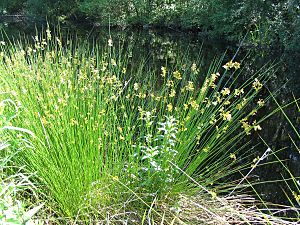Juncus effusus facts for kids
Quick facts for kids Juncus effusus |
|
|---|---|
 |
|
| Scientific classification | |
| Genus: |
Juncus
|
| Species: |
effusus
|
| Synonyms | |
|
List
|
|
Juncus effusus, often called the common rush or soft rush, is a type of flowering plant that lives for many years. It belongs to the Juncaceae family. In North America, the common name "soft rush" can also refer to a similar plant called Juncus interior.
Contents
Where Does the Common Rush Grow?
The common rush grows almost everywhere in the world. It is naturally found in Europe, Asia, Africa, North America, and South America. It has also started growing in new places like Australia, Madagascar, and many islands.
You can find this plant in wet areas. It loves places like wetlands, along rivers and streams (called riparian areas), and marshes. In the United Kingdom, it grows in special plant groups like purple moor-grass pastures and fen-meadows.
What Does the Common Rush Look Like?
The common rush grows in large groups. These clumps can reach about 1.5 meters (about 5 feet) tall. You often see them at the edges of streams and ditches. They can also grow in any moist soil. This plant is commonly found in rich, wet soil, such as in marshes, ditches, fens, and near beaver dams.
The stems of the common rush are smooth and round. They are filled with a light, spongy material called pith. The yellowish flowers grow in a cluster that seems to come out of the side of the stem. This cluster appears about 20 centimeters (8 inches) from the top. Actually, the stem ends there, and the top part is a special leaf called a bract. It looks like a continuation of the stem with just a slight color change. The lower leaves are very small and look like brown coverings at the bottom of the stem.
Different Types of Common Rush
Scientists have identified five main types, or subspecies, of Juncus effusus:
- Juncus effusus subsp. austrocalifornicus — This type is found only in California and Baja California.
- Juncus effusus subsp. effusus — This is the most common type and grows in many places.
- Juncus effusus subsp. laxus — You can find this type in tropical Africa, Madagascar, Mauritius, the Canary Islands, and Madeira.
- Juncus effusus subsp. pacificus — This type grows in Alaska, British Columbia, Washington, Idaho, Oregon, California, and Baja California.
- Juncus effusus subsp. solutus — This type is found in the central and eastern parts of the United States.
You can tell Juncus effusus apart from a rarer plant called Juncus pylaei by looking at the ridges on their stems. Juncus effusus has 30 to 40 ridges, while J. pylaei has only 10 to 20.
How is the Common Rush Used?
Helping Wildlife
The common rush provides important habitats for many animals. It offers places for wild birds and wading birds to feed and build nests. Small mammals also use the plant for shelter. The underground stems, called rootstalks, are eaten by muskrats. Birds often hide among the plant's stems. Many small creatures, like the rufous minor moth, also feed on the soft rush.
Uses for People
Juncus effusus is one of the seven ingredients in a special drink called Hui sup tea. In Japan, this rush is grown and woven to make the top layer of tatami mats, which are traditional Japanese floor coverings. In Iran and Afghanistan, it is also used to weave light, inexpensive mats. There, it is called halfa (حلفا) and is also used for some traditional medicines. In Europe, people once used the pith (the soft inside) of this rush to make rushlights. These were a cheap way to make light by soaking the pith in grease, like a simple candle.
Growing Common Rush in Gardens
This plant is grown as an ornamental plant because it looks nice. People plant it in water gardens, native plant gardens, and wildlife gardens. It is also used in bigger projects to create natural landscaping and restore natural habitats.
There is a special type of common rush called Juncus effusus 'Spiralis'. It is also known as corkscrew rush or spiral rush. This type is very popular for potted plants and water gardens because its leaves are wonderfully curled like a spiral.
Managing Common Rush Growth
Sometimes, Juncus effusus can spread too much and become an invasive species. This can be a problem in grazing areas because livestock do not like to eat it. Ways to control the rush include plowing the land. Another method is to use a lot of fertilizer, but this can sometimes pollute water. Cutting the tops of the plants (called topping) can also help stop them from making seeds.
See also
 In Spanish: Junco de esteras para niños
In Spanish: Junco de esteras para niños


